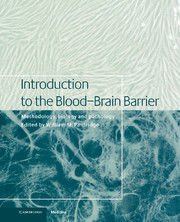Book contents
- Frontmatter
- Contents
- List of contributors
- 1 Blood–brain barrier methodology and biology
- Part I Methodology
- Part II Transport biology
- Part III General aspects of CNS transport
- Part IV Signal transduction/biochemical aspects
- 31 Regulation of brain endothelial cell tight junction permeability
- 32 Chemotherapy and chemosensitization
- 33 Lipid composition of brain microvessels
- 34 Brain microvessel antigens
- 35 Molecular dissection of tight junctions: occludin and ZO-1
- 36 Phosphatidylinositol pathways
- 37 Nitric oxide and endothelin at the blood–brain barrier
- 38 Role of intracellular calcium in regulation of brain endothelial permeability
- 39 Cytokines and the blood-brain barrier
- 40 Blood–brain barrier and monoamines, revisited
- Part V Pathophysiology in disease states
- Index
36 - Phosphatidylinositol pathways
from Part IV - Signal transduction/biochemical aspects
Published online by Cambridge University Press: 10 December 2009
- Frontmatter
- Contents
- List of contributors
- 1 Blood–brain barrier methodology and biology
- Part I Methodology
- Part II Transport biology
- Part III General aspects of CNS transport
- Part IV Signal transduction/biochemical aspects
- 31 Regulation of brain endothelial cell tight junction permeability
- 32 Chemotherapy and chemosensitization
- 33 Lipid composition of brain microvessels
- 34 Brain microvessel antigens
- 35 Molecular dissection of tight junctions: occludin and ZO-1
- 36 Phosphatidylinositol pathways
- 37 Nitric oxide and endothelin at the blood–brain barrier
- 38 Role of intracellular calcium in regulation of brain endothelial permeability
- 39 Cytokines and the blood-brain barrier
- 40 Blood–brain barrier and monoamines, revisited
- Part V Pathophysiology in disease states
- Index
Summary
General considerations concerning the phosphatidylinositol cycle
The discovery of the ‘phosphoinositide effect’ by Hokin and Hokin as early as in 1953 (Hokin and Hokin, 1953) demonstrating that acetylcholine could stimulate the incorporation of 32Pi into phosphatidylinositol (PI) and phosphatidic acid (PA), revealed the association between hormone action and phospholipid turnover. Later, the agonistinduced phosphoinositide turnover and its relationship to Ca2+ signaling were described (Michell, 1975). The fact that the hydrolysis of phosphatidylinositol bisphosphate (PIP2) by a phosphoinositide – specific phospholipase C yields two second messengers: 1,2-diacylglycerol (DAG), which activates protein kinase C and inositol 1,4,5-trisphosphate (IP3) which mobilizes Ca2+ from intracellular stores, was demonstrated (Streb et al., 1983).
Although reported some years ago, this phosphoinositide field is currently one of the most interesting fields in biochemistry, which has witnessed during the past decade a tremendous increase in the knowledge of the PI pathway. To gain more insights into this field the following roles are studied: the nuclear metabolism of the PI cycle, the role of phosphatases and the role of higher phosphorylated forms as IP4, IP5 and IP6 (Heslop et al., 1985; Malviya et al., 1990; Henzi and McDermott, 1992). In this regard, phosphoinositide-mediated signal transduction in the nervous system is no exception, and a general view of the PI pathway is now available (Fisher et al., 1992).
- Type
- Chapter
- Information
- Introduction to the Blood-Brain BarrierMethodology, Biology and Pathology, pp. 330 - 337Publisher: Cambridge University PressPrint publication year: 1998



